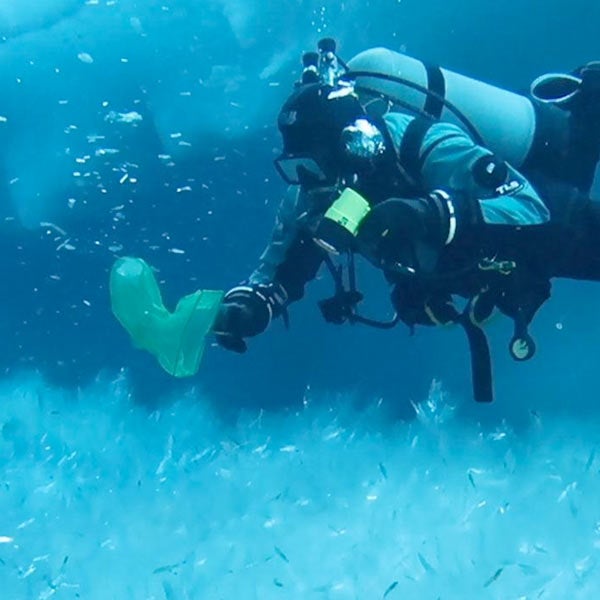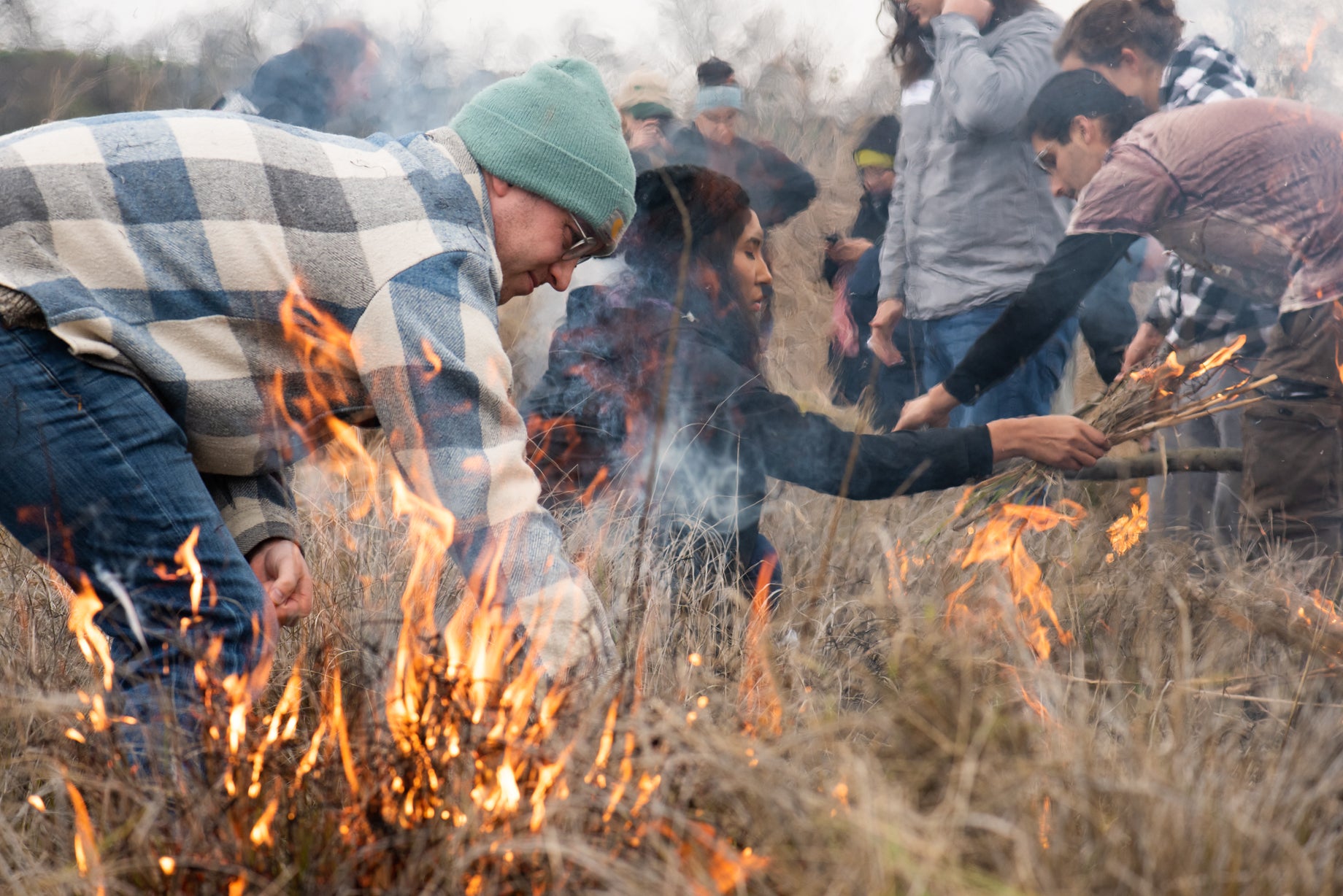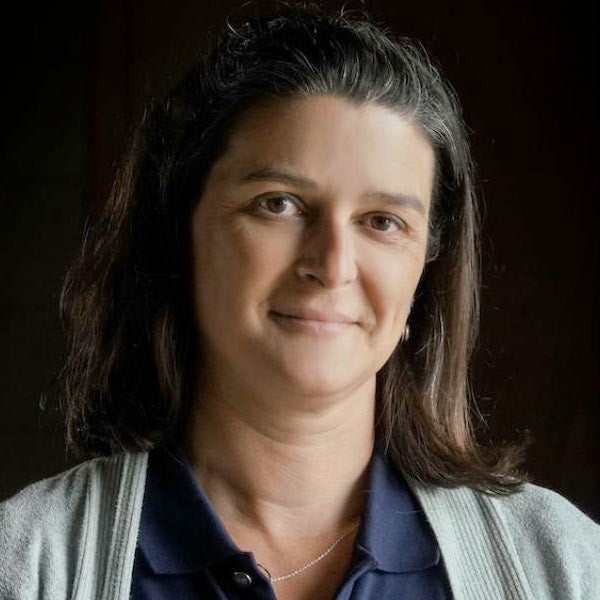Melinda Adams is an environmental scientist, Ph.D. candidate in Native American studies and member of the San Carlos Apache Tribe. She helps teach UC Davis' "Keepers of the Flame" class, in which students work with Indigenous fire practitioners to reclaim the practice of cultural burning - which uses fire as a tool for land restoration, not destruction.

This article is part 4 of the series "Confronting Climate Anxiety"
View all eight parts of the series, and find out what scientists are doing to turn climate anxiety into climate action.
Hers is a unique voice that amplifies and weaves together Native American studies, environmental science, ecology and climate change solutions through a lens of Indigenous land stewardship and cultural inclusivity.
How do you feel when you're at a cultural burn?
For me, I think there's a lot of healing that happens. We're not just healing the landscape with this good fire that's going to regenerate plants and cut back fuel loads and raise the water table. This was a practice that was taken away from Indigenous peoples. We're literally taking these practices back and stewarding our lands while healing ourselves, culturally. And we're doing it with elders, young folks and even little kids. We're participating in a community of healing.

In the beginning stages of my research, I used the word "revitalizing," but one of my elders said, "Melinda, we're not 'revitalizing' fire. These ways are not dead; they didn't go anywhere. We're reclaiming them." I thought that was a pretty powerful "auntie" lesson.
Are there common misconceptions you'd like to share about cultural burning?
Cultural burning can differ from prescribed or controlled burning. It's very tribe-centric and place-specific. The lessons and solutions you learn in one area aren't necessarily translatable to another. For cultural burns, you need to build community in each place. These partnerships have to be created and sustained first with the C's: consultation, collaboration and consent. And also the R's: respect, responsibility and reciprocity, all upheld with the tribe. Grounding your approaches in those relational contexts is key.
What are some of your early memories around connecting with the environment?
I grew up in New Mexico, and where my mother and father have close connections to their tribal homelands. Learning about the environment through storytelling, storysharing and placing ourselves within the environment was such a holistic way to learn my responsibilities to the land and how to carry myself as an Indigenous woman

What led you to get involved with studying fire?
I'll tell you the academic story and the family story.
The academic story is that after I finished undergrad at a tribal college in Kansas, I found my way to plant ecology and environmental science at Purdue by working with biochar, a soil amendment and form of charcoal created through burning. It's a conservation restoration tool created by Indigenous people in the Amazon basin. Like with cultural burning, they purposely burned for millennia for many reasons - to sustain communities with food, get rid of waste, to make healthy soils. I was captivated by this!
We decided to apply the practice to tallgrass prairie - one of the most devastated ecosystems in the United States. I participated in some prairie burns, and we had good results with our biochar research. That was inspiring. This is how I got into fire research.
We're participating in a community of healing.
Then there's the family story: A lot of our Native communities have a dark history of removal, and we don't always want to share part of the past related to intergenerational trauma. Recently, my mother shared something with me. She never told me this until I brought up my research with cultural fire. She said, "You know, I fought fire as a young person."
I was like, "What?!"
"Yeah! Every summer in Arizona, I served as a wildland firefighter for our tribe. You come from a line of fire keepers. It's in your blood."
I'm sure that was a surprise! So, two key questions: Do you feel climate anxiety, and what do you do about it in those moments?
I grapple with my approach to climate anxiety. I think we need to confront that we're experiencing it, especially here in California, with drought and wildfire. When I was in the Midwest, I taught about air pollution and smog by showing pictures of New York and California. Now I'm here and seeing it. And the orange skies are something we have to prepare ourselves for. That struck me, vividly. This is happening. We all need to pay attention and think about collective climate solutions.
As a Native community member, I see firsthand how extreme climatic events displace, remove and leave our people in vulnerable positions environmentally and with our public and mental health. In most instances, our culture, language and identities are formed through our connections with lands and waters. So when our homelands are degraded or when we're removed from them, there are threats to cultures that have persisted for millennia. That's a heavy thing to carry.

I choose to remain committed to the work I do because there are elders, tribal members and young people all in a sense relying on the work I help with to dispel a lot of the misconceptions about Native Peoples and to respectfully foreground our land stewardship practices. Given the spaces and fields I have access to, it's my responsibility to challenge the oversimplification and erasure of my Peoples.
That's kind of what lights the fire, if you'll forgive the pun. We talk a lot about responsibility in our community. We want to be good relatives so that one day we can be good ancestors.
What excites you about the work you do?
For people who study climate change, it can be disheartening. They know the statistics and what the science is pointing to. It's hard to remain optimistic and solutions oriented. But I'm seeing and feeling a shift in people's perspective.

I think the surge of social justice movements in 2020 demands that we look at how certain perspectives have been left out of national conversations and how we must invite these perspectives into climate solutions. I think we're experiencing a moment, and it might be naive of me, but I see this as an opportunity. We can return the gaze. I think if we could have had a broader Indigenous perspective hundreds of years ago, perhaps some of these climate change issues would probably not be occurring at the rate they are.
I think we're experiencing a moment, and it might be naive of me, but I see this as an opportunity. We can return the gaze.
That's a great way of tying together the social justice and climate change issues. They really can't be separated.
Yes! For example, I recently served on the committee to rename the John Muir Institute of the Environment here at UC Davis. We heard from people wanting to keep it and from Native peoples about how we need to stop naming things for people who have caused harm to underrepresented communities. At the end of the day, as a committee, we voted to rename JMIE and now it's the UC Davis Institute of the Environment.
For me, that was such an exciting moment! Being part of the renaming dialogue was a way to uplift the visibility of my people, especially in a space dedicated to science and climate research. It was a bit of a heavy load to carry in educating people about why it's necessary. But changes like these are profound.
[My ancestors] never gave up. They withstood colonization and the collapse of their worlds. Who am I to give up when they didn't?
When I was brought up, I heard stories about people fighting for change, whether it be for federal status recognition or environmental issues. My relatives shared with me: "I might not ever see that change in my lifetime. We come to these spaces and fight our fights with this in mind." We lead with, "I'm not doing this for me, but for my children, my grandchildren."
So to see something like a renaming, or a racial slur like the Redskins or the Indians be changed. To see Deb Haaland, a tribal member and U.S. secretary of the interior be the highest-ranked government official overseeing the greatest proportion of our public lands … I'm not an elder yet, but I never thought I'd see that change in my lifetime!

I think that extends to a lot of underrepresented communities. There's such momentum in social and environmental activism right now. Our youth are taking on the challenge of climate change. They inherited this, but they're savvy and smart. They're calling out racial injustices. They are very prepared to take on this fight.
I share your admiration for today's youth. But I also know some young people are quite anxious and scared about the future. Some quite literally think the world is about to end. There are videos of kids on Tik Tok in tears over climate anxiety. Do you have any thoughts or advice for them?
I would say their feelings are very real, they are valid, and I understand. For example, some students taking the "Keepers of the Flame" class have climate anxiety, some were displaced from wildfire. The point of taking the class is to have that change in perception of our approaches to stewardship. Cultural burning and other Indigenous-led environmental practices are led with our future, all people's future, in mind.
For me, I haven't reached the point of feeling like there might not be a future or a California. That might be how I choose to see the world based on the stories of resiliency and hope I've inherited from my ancestors.
They never gave up. They withstood colonization and the collapse of their worlds. Who am I to give up when they didn't? They didn't give up on their youth or their future, and neither will I.

Continue the series with part 5, "Tessa Hill: Telling the Ocean's Secrets"
In part 5, UC Davis marine geochemist Tessa Hill talks about the emotional burdens and joys of studying climate change.






